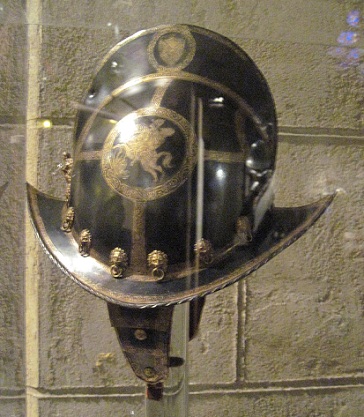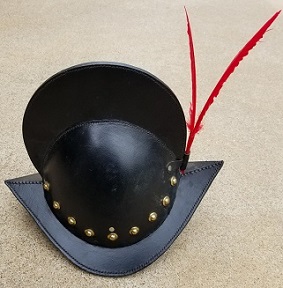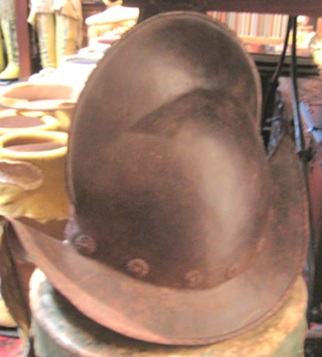Subject: Trabantengarde noble bodyguard
Culture: German Saxon
Setting: Reformation, Germany late 16th-17thc
Object: Rüstung armor
Metropolitan Museum of Art > Stone Gallery of Arms and Armor *
"Half Armor Blued steel German (Nuremberg), 1610-20 Although entirely made in Nuremberg, this light cuirassier's armor is an interesting mix of regional styles. The helmet is based on an eastern European type known as the Zischägge, which was inspired by Turkish examples. The pauldrons (shoulder defenses) with their overlapping, fan-like plates are of a type associated with Swiss armors of the period.
* Metropolitan Museum of Art > Stone Gallery of Arms and Armor
"Foot-Combat Armor of Prince-Elector Christian I of Saxony Steel, etched, blued, and gilt; leather; gilt bronze
Anton Peffenhauser (1525-1603); decoration attributed to Jorg Sorg the Younger (about 1522-1603) German (Augsburg), 1591
This is one of a set of twelve matching armors for foot combat commissioned in 1591 by Sophie of Brandenburg as a Christmas gift for her husband, Christian I (reigned 1586-91). These armors were among the last commissions of Anton Peffenhauser, the leading Augsburg armorer during the second half of the sixteenth century.
"Combat on foot between contestants separated by a waist-high barrier was a popular sport in European courts of the sixteenth and seventeenth centuries. It could be staged indoors or out and was fought with pikes and swords, for each of which a prescribed number of blows was allowed. The presence of the barrier and strict rules prohibiting strikes below the belt made leg armor unnecessary."
Metropolitan Museum of Art > Stone Gallery of Arms and Armor *
"Burgonet Steel, etched, gilt, and painted; gilt brass; textile German (Augsburg), 1575-1600
Helmets of this type were probably worn by the mounted troops of the bodyguards of the
prince-electors of Saxony. This helmet retains its original padded lining covered with yellow silk." ...
* Higgins Armory Museum > Great Hall
"Comb Morion, about 1590 German (Nuremberg)
For the guards of Christian or Christian II, Electors of Saxony
Blackened steel with etched and gilded decoration; brass; leather Weight: 4 lbs." ...
Metropolitan Museum of Art > Stone Gallery of Arms and Armor *
"Morion Steel, etched, silvered, and painted; gilt brass; glass
German (Nuremberg), late sixteenth century
Silvered morions of this type were probably worn by the officers
of the bodyguards of the prince-electors of Saxony." ...
*
* Metropolitan Museum of Art > Stone Gallery of Arms and Armor
"Two Morions for the Bodyguard of the Prince-Elector of Saxony Steel,
etched and gilt; gilt brass; leather German (Nuremberg), about 1570 (one dated 1568)
The electors of Saxony appear to have been the only German princes in the sixteenth
century to outfit their bodyguards with matching equipment. The guards' helmets are
etched and gilt on one side with the coat of arms of the dukedom of Saxony and on the
other side with the crossed swords that signify the duke's office as archmarshal of the
Holy Roman Empire. The gilt decoration was originally contrasted with black painted
surfaces (some now polished bright). The black and gold derived from the Saxon coat
of arms and were also the colors of the guards' livery. Both helmets were made by
armorers in Nuremberg.
"The example on the left is dated 1568. The only dated morion of this series known,
it establishes the creation and use of the guard morions in the reign of August I (1553-86),
twenty to thirty years earlier than previously thought." ....
Metropolitan Museum of Art > Stone Gallery of Arms and Armor *
"Gauntlet Steel, engraved, silvered, and gilt;
brass; leather German, late 16th century"
* Metropolitan Museum of Art > Stone Gallery of Arms and Armor
"Two Morions for the Bodyguard of the Prince-Elector of Saxony
Steel, etched and gilt; gilt brass; leather German (Nuremberg) about 1570
The electors of Saxony appear to have been the only German princes in the
sixteenth century to outfit their bodyguards with matching equipment. The
guards' helmets are etched and gilt on one side with the coat of arms of the
dukedom of Saxony and on the other side with the crossed swords that signify
the duke's office as archmarshal of the Holy Roman Empire. The gilt decoration
was originally contrasted with black painted surfaces (some now polished bright).
The black and gold derived from the Saxon coat of arms were also the colors of
the guards' livery. Both helmets were made by armorers in Nuremberg." ...
Metropolitan Museum of Art > Stone Gallery of Arms and Armor *
* FF


